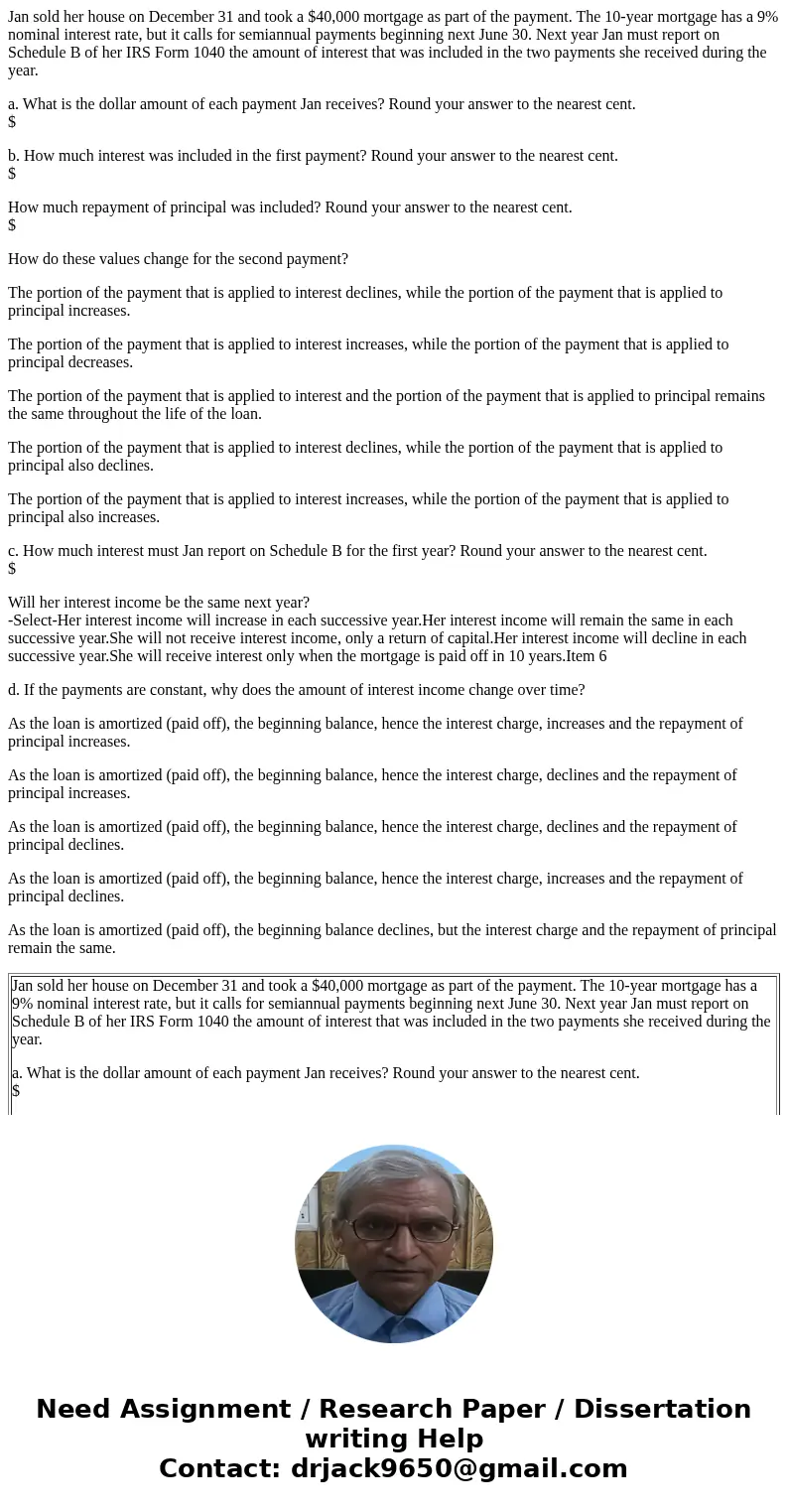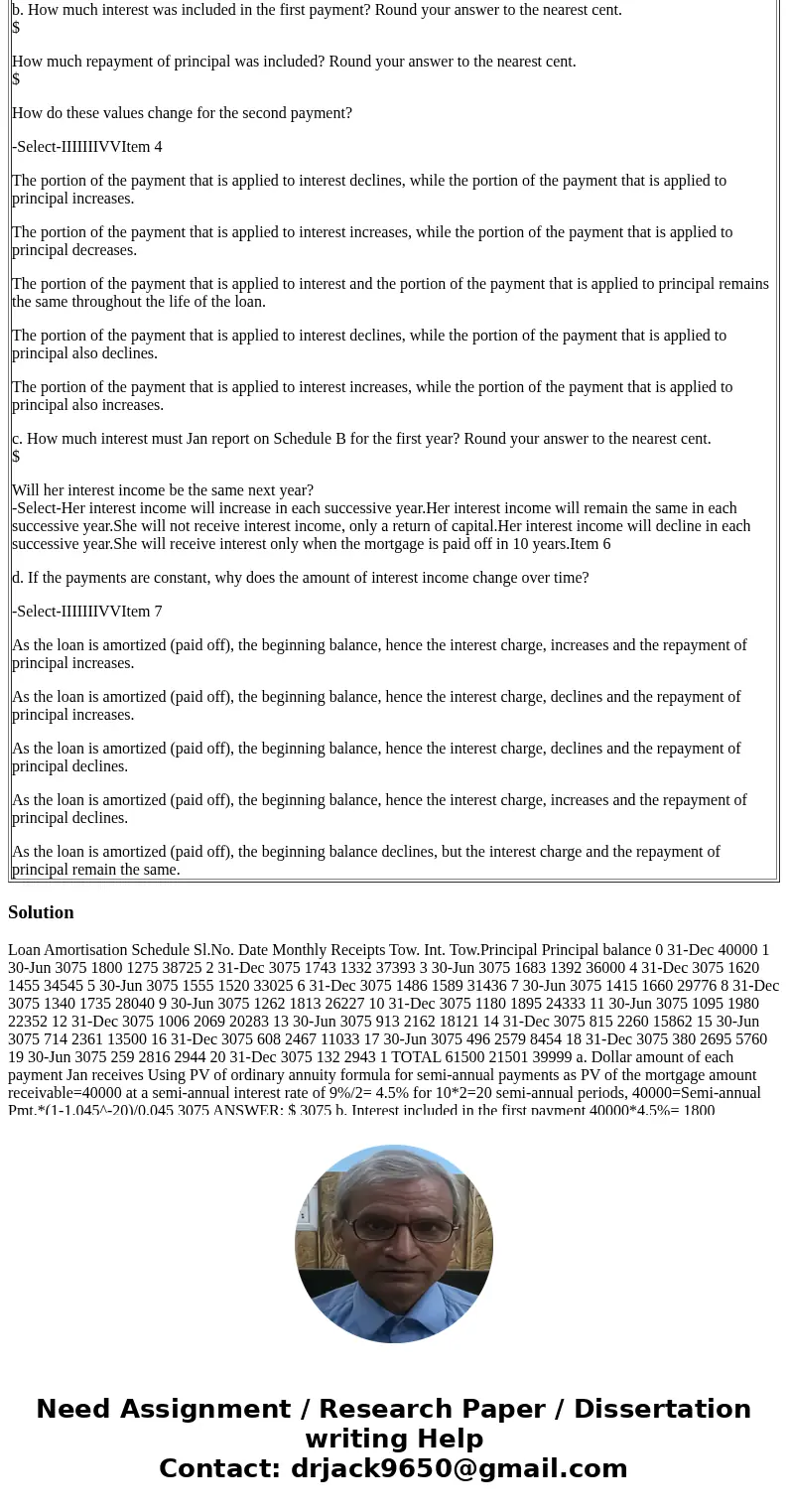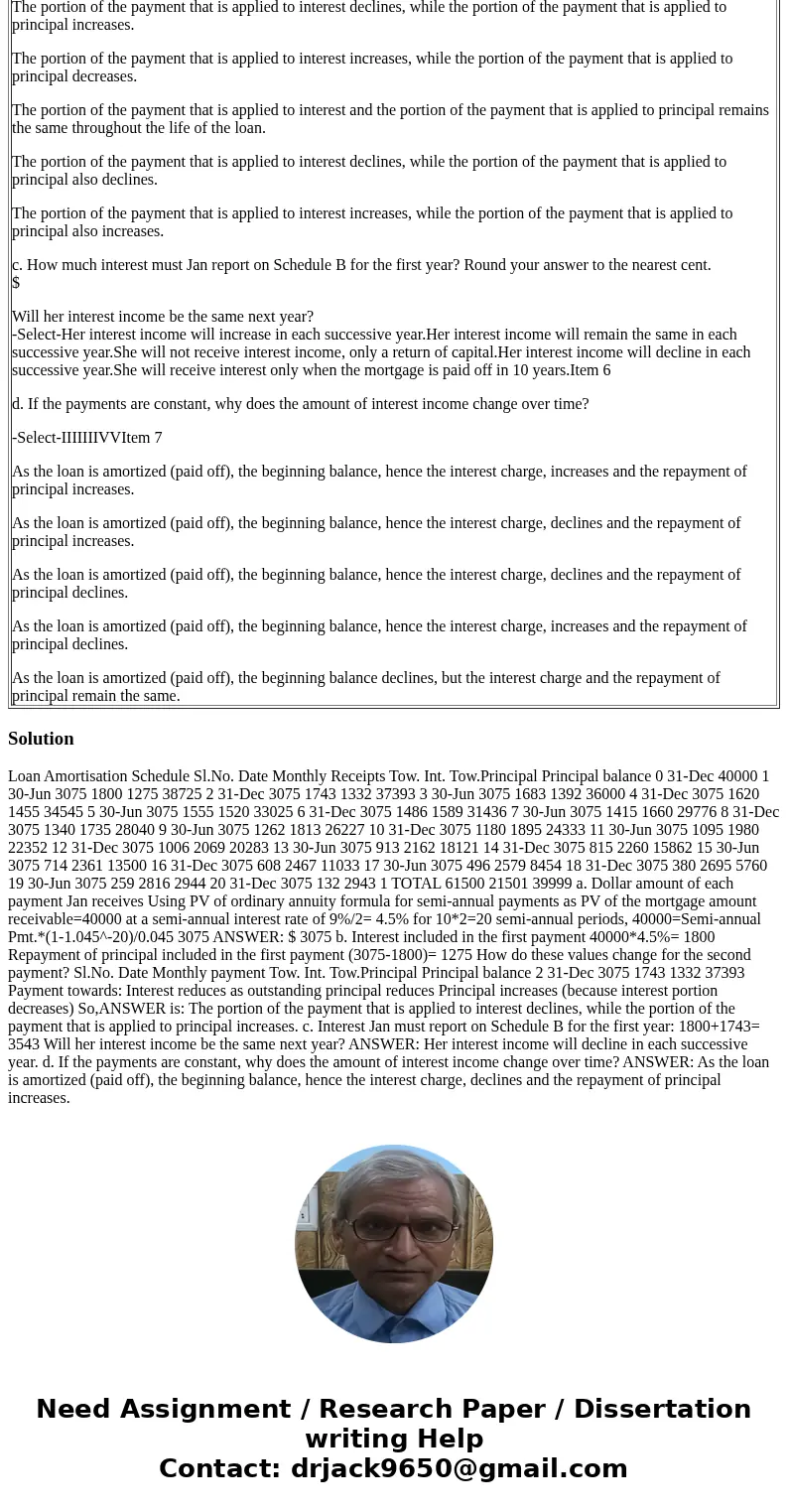Jan sold her house on December 31 and took a 40000 mortgage
Jan sold her house on December 31 and took a $40,000 mortgage as part of the payment. The 10-year mortgage has a 9% nominal interest rate, but it calls for semiannual payments beginning next June 30. Next year Jan must report on Schedule B of her IRS Form 1040 the amount of interest that was included in the two payments she received during the year.
a. What is the dollar amount of each payment Jan receives? Round your answer to the nearest cent.
$
b. How much interest was included in the first payment? Round your answer to the nearest cent.
$
How much repayment of principal was included? Round your answer to the nearest cent.
$
How do these values change for the second payment?
The portion of the payment that is applied to interest declines, while the portion of the payment that is applied to principal increases.
The portion of the payment that is applied to interest increases, while the portion of the payment that is applied to principal decreases.
The portion of the payment that is applied to interest and the portion of the payment that is applied to principal remains the same throughout the life of the loan.
The portion of the payment that is applied to interest declines, while the portion of the payment that is applied to principal also declines.
The portion of the payment that is applied to interest increases, while the portion of the payment that is applied to principal also increases.
c. How much interest must Jan report on Schedule B for the first year? Round your answer to the nearest cent.
$
Will her interest income be the same next year?
-Select-Her interest income will increase in each successive year.Her interest income will remain the same in each successive year.She will not receive interest income, only a return of capital.Her interest income will decline in each successive year.She will receive interest only when the mortgage is paid off in 10 years.Item 6
d. If the payments are constant, why does the amount of interest income change over time?
As the loan is amortized (paid off), the beginning balance, hence the interest charge, increases and the repayment of principal increases.
As the loan is amortized (paid off), the beginning balance, hence the interest charge, declines and the repayment of principal increases.
As the loan is amortized (paid off), the beginning balance, hence the interest charge, declines and the repayment of principal declines.
As the loan is amortized (paid off), the beginning balance, hence the interest charge, increases and the repayment of principal declines.
As the loan is amortized (paid off), the beginning balance declines, but the interest charge and the repayment of principal remain the same.
| Jan sold her house on December 31 and took a $40,000 mortgage as part of the payment. The 10-year mortgage has a 9% nominal interest rate, but it calls for semiannual payments beginning next June 30. Next year Jan must report on Schedule B of her IRS Form 1040 the amount of interest that was included in the two payments she received during the year. a. What is the dollar amount of each payment Jan receives? Round your answer to the nearest cent. b. How much interest was included in the first payment? Round your answer to the nearest cent. How much repayment of principal was included? Round your answer to the nearest cent. How do these values change for the second payment? -Select-IIIIIIIVVItem 4The portion of the payment that is applied to interest declines, while the portion of the payment that is applied to principal increases. The portion of the payment that is applied to interest increases, while the portion of the payment that is applied to principal decreases. The portion of the payment that is applied to interest and the portion of the payment that is applied to principal remains the same throughout the life of the loan. The portion of the payment that is applied to interest declines, while the portion of the payment that is applied to principal also declines. The portion of the payment that is applied to interest increases, while the portion of the payment that is applied to principal also increases. c. How much interest must Jan report on Schedule B for the first year? Round your answer to the nearest cent. Will her interest income be the same next year? d. If the payments are constant, why does the amount of interest income change over time? -Select-IIIIIIIVVItem 7As the loan is amortized (paid off), the beginning balance, hence the interest charge, increases and the repayment of principal increases. As the loan is amortized (paid off), the beginning balance, hence the interest charge, declines and the repayment of principal increases. As the loan is amortized (paid off), the beginning balance, hence the interest charge, declines and the repayment of principal declines. As the loan is amortized (paid off), the beginning balance, hence the interest charge, increases and the repayment of principal declines. As the loan is amortized (paid off), the beginning balance declines, but the interest charge and the repayment of principal remain the same. |
Solution
Loan Amortisation Schedule Sl.No. Date Monthly Receipts Tow. Int. Tow.Principal Principal balance 0 31-Dec 40000 1 30-Jun 3075 1800 1275 38725 2 31-Dec 3075 1743 1332 37393 3 30-Jun 3075 1683 1392 36000 4 31-Dec 3075 1620 1455 34545 5 30-Jun 3075 1555 1520 33025 6 31-Dec 3075 1486 1589 31436 7 30-Jun 3075 1415 1660 29776 8 31-Dec 3075 1340 1735 28040 9 30-Jun 3075 1262 1813 26227 10 31-Dec 3075 1180 1895 24333 11 30-Jun 3075 1095 1980 22352 12 31-Dec 3075 1006 2069 20283 13 30-Jun 3075 913 2162 18121 14 31-Dec 3075 815 2260 15862 15 30-Jun 3075 714 2361 13500 16 31-Dec 3075 608 2467 11033 17 30-Jun 3075 496 2579 8454 18 31-Dec 3075 380 2695 5760 19 30-Jun 3075 259 2816 2944 20 31-Dec 3075 132 2943 1 TOTAL 61500 21501 39999 a. Dollar amount of each payment Jan receives Using PV of ordinary annuity formula for semi-annual payments as PV of the mortgage amount receivable=40000 at a semi-annual interest rate of 9%/2= 4.5% for 10*2=20 semi-annual periods, 40000=Semi-annual Pmt.*(1-1.045^-20)/0.045 3075 ANSWER: $ 3075 b. Interest included in the first payment 40000*4.5%= 1800 Repayment of principal included in the first payment (3075-1800)= 1275 How do these values change for the second payment? Sl.No. Date Monthly payment Tow. Int. Tow.Principal Principal balance 2 31-Dec 3075 1743 1332 37393 Payment towards: Interest reduces as outstanding principal reduces Principal increases (because interest portion decreases) So,ANSWER is: The portion of the payment that is applied to interest declines, while the portion of the payment that is applied to principal increases. c. Interest Jan must report on Schedule B for the first year: 1800+1743= 3543 Will her interest income be the same next year? ANSWER: Her interest income will decline in each successive year. d. If the payments are constant, why does the amount of interest income change over time? ANSWER: As the loan is amortized (paid off), the beginning balance, hence the interest charge, declines and the repayment of principal increases.


 Homework Sourse
Homework Sourse